Balancing industry, identity and the environment: how a carbon-intensive city in northern Japan is narrating a low-carbon transition
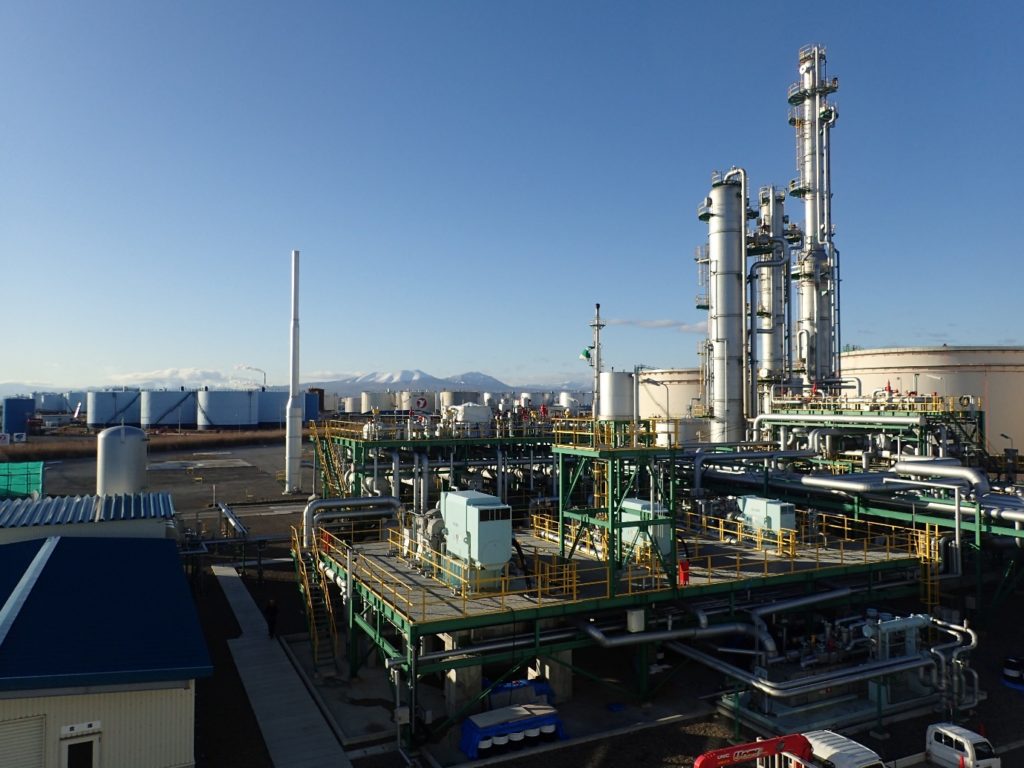
DOI reference: 10.1080/13673882.2018.00001016
By Leslie Mabon, Reader in Environment and Society, Robert Gordon University, UK.
Leslie Mabon presents research from his RSA early career grant funded research on low carbon transitions in carbon intensive regions. Drawing on evidence from a case study of Tomakomai city, Japan, he suggests effective transitions benefit from positive narratives focused on low carbon infrastructure.
:Introduction:
The purpose of this article is to elaborate the ways in which social and cultural context can act as barriers to change in cities and regions that rely heavily on carbon-intensive industries, and to consider how factors such as pride in productivity and innovation may be redeployed to facilitate low-carbon transitions in carbon-intensive regions. These issues are assessed through the case of Tomakomai City in Hokkaido, Japan, with particular focus on how the city government has used carbon dioxide capture and storage (CCS) technology as a symbol of how industries might adapt and evolve to meet the challenge of climate change.
Tomakomai and carbon dioxide capture and storage
Tomakomai is located in the south of Hokkaido, the northernmost island of Japan, within Iburi Subprefecture. It has a population of approximately 172,000 (Tomakomai City, 2017), making it the fifth-largest city in Hokkaido. The economy of Tomakomai is to a large extent dependent on manufacturing, notably in the carbon-intensive sectors of petrochemicals and paper manufacturing, which are the largest single employers after transportation (Tomakomai City, 2017). Indeed, in 2012 Tomakomai City produced petrochemical-related goods with a value of 837 billion Yen and in 2015 Tomakomai was responsible for 23% of the value of all goods manufactured in Hokkaido, making a larger contribution to this figure than any other city in the region (Tomakomai City, 2017). Moreover, Tomakomai City is also the host for the Tomato-Atsuma Power Station, which with a capacity of 1,650MW is the largest coal-fired power station in Hokkaido (Hokkaido Electric, 2018). The second-biggest contributor to the value of manufactured goods in Hokkaido, the steel manufacturing city of Muroran, is also located in Iburi Subprefecture.
Figure 1: location of Tomakomai within Hokkaido (adapted from map tiles by Stamen Design, under CC BY 3.0. Data by CARTO (formerly CartoDB) and OpenStreetMap, under ODbL)
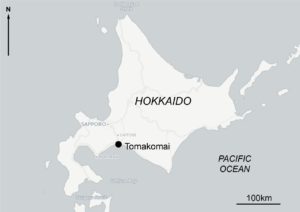
Figure 2: location of key infrastructure and carbon-intensive sites within Tomakomai (adapted from Geospatial Information Authority of Japan)
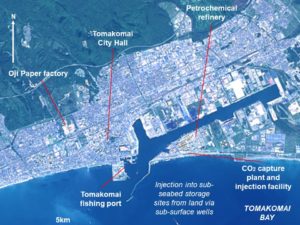
Alongside this pride in the city’s industries, the climate change implications of the industrial sectors which are so central to Tomakomai’s economy are also recognised. Japan’s submission to the Paris Agreement identifies the energy and industrial sectors as the priority areas for emissions reduction, with explicit mention of the need for measures in the chemical and pulp industries under the ‘industrial’ heading (Government of Japan, 2015). Whilst there is no indication that industries in Tomakomai or in Iburi Subprefecture will be ‘shut down’ to meet these targets, it is nonetheless indicative of the fact that the types of industrial activity which are crucial to Tomakomai are likely to face increased scrutiny as Japan aims to meet its obligations under the Paris Agreement.
It is therefore fitting that Tomakomai City is host to Japan’s first large-scale demonstration of a technology with the potential to help the electricity and manufacturing sectors meet climate change imperatives, carbon dioxide capture and storage (CCS). CCS involves capturing carbon dioxide emissions from power or industrial sources, transporting these by ship or pipeline, and injecting them into geological structures deep underground. The project in Tomakomai has been developed and operated by the Japan CCS Company, under the direction of the Ministry of Economy, Trade and Industry. Since 2016, carbon dioxide has been captured from a gasification plant within the grounds of the Idemitsu oil refinery in the east of Tomakomai, and injected into two geological stores via wells drilled under the seabed from land (Japan CCS Company, 2018). This article assesses the significance of the city government in facilitating CCS deployment, and evaluates the role of academic research in helping to situate technologies such as CCS within a bigger context of a managed transition for carbon-intensive cities and regions like Tomakomai.
Finally, whilst writing this article, it should be noted that on the morning of Thursday 6 September 2018, a Magnitude 6.7 earthquake struck the central southern part of Hokkaido. Shindo 7, the maximum intensity on the Japan Meteorological Agency scale, was observed less than 20km from Tomakomai and as many as 40 people were killed by the earthquake and subsequent landslides, mainly in Atsuma Town adjacent to Tomakomai (Hokkaido Government, 2018). The earthquake triggered emergency shutdowns at thermal power stations in Hokkaido, including at the Tomato-Atsuma plant which supplies around 40-50% of electricity to the island. Electricity demand therefore exceeded supply, resulting in blackouts across Hokkaido lasting several days. Whilst it is important not to detract from the lives lost as a result of the earthquake, and whilst there is no indication at present that the earthquake is related to CCS activity, the event does underscore the dependence of Tomakomai and Hokkaido more widely on carbon-intensive energy sources.
Overview of the Research
This research starts from the basis that social and cultural factors have a significant influence on the prospects for a city or region being able to transition its economy in response to energy or environmental changes. For example, another line of research undertaken as part of this project in Yubari, a former mining city to the north of Tomakomai, found a range of complex factors contributed to the city’s initial struggle and subsequent success in managing a sustainability tradition post-coal. These included strong local identity associations with coal as a barrier to diversification; but latterly the personal vision of the city’s young mayor, and interpersonal skills of the city’s planners (Mabon and Shih, 2018).
In short, the research aimed to understand how potentially less tangible or quantifiable factors could inform the likelihood or otherwise of low-carbon transitions taking root. These insights were in turn used to assess framings for low-carbon innovations that could help to envision a just and managed transition for carbon-intensive cities like Tomakomai. This narrative was fleshed out through three research techniques: (a) understanding the history of industrial development in Tomakomai through archival research in Tomakomai City Library, looking at reporting from the Tomakomai Minpo newspaper and historical environmental impact assessments; (b) in-depth interviews with key stakeholders with an interest in the Tomakomai carbon dioxide capture and storage project (Tomakomai City Government, Japan CCS Company, Tomakomai Komazawa University, Tomakomai City Chamber of Commerce, Tomakomai Fisheries Cooperative, Tomakomai Port Authority, Engineering Advancement Association of Japan, Hokkaido Regional Development Association, Hokkaido Environment Foundation, and Hokkaido Government); and (c) ethnography/observation at key locations relating to climate change in Tomakomai, including the CCS injection site and the climate change information section at Tomakomai City Hall.
Measures such as validity and replicability are not appropriate for qualitative research of this nature. Rather, what matters is that the research is carried out in a rigorous manner. To work towards rigour in the research discussed here, the following steps were undertaken: keeping records of publicly-available archive and documentary sources to allow independent verification; using semi-structured guides for interviews to ensure that all respondents covered a core set of topics; making records of observations through note-taking and photography; evaluation of findings in terms of their fit with underpinning theory and empirical studies conducted by others; and refinement of findings via dialogue with other social science scholars, through processes such as conference presentation and peer review.
Insights
The first insight from the empirical research, particularly the more ethnographic elements, is the extent to which carbon-intensive industries are central to a sense of place in Tomakomai (see Mabon et al, 2017 for a fuller history of industrial development in Tomakomai). In the city, petrochemicals and paper manufacturing permeate daily living in a number of ways. The city’s main greenspace, within which both the city library and museum are located, is named the Idemitsu Culture Park after the petroleum company owning a large refinery in east Tomakomai (see Figure 3). The red-and-white chimney of the Oji Paper factory, which towers over the city at 200m high, is frequently deployed in cartoon form in public-facing material produced by Tomakomai City Government (see Figure 4). Carbon-intensive industries also inform people’s sense of who they are and – at least in part – act as a source of pride. The tanks of the oil refinery and paper factory chimneys form the backdrop for Tomakomai Style (苫小牧スタイル), a parody of the Korean pop music hit Gangnam Style with over 100,000 views on YouTube (). The Oji Eagles, founded and owned by the Oji Paper company, are based in Tomakomai and rank as one of the most successful ice hockey teams in Asia.
Figure 3: Idemitsu Culture Park, Tomakomai
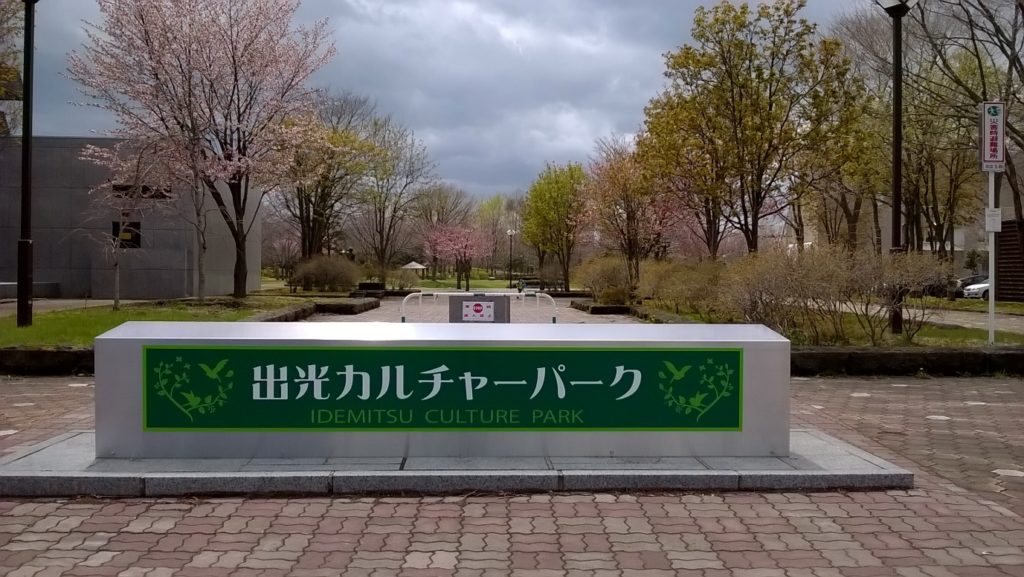
Figure 4: Oji Paper Factory chimneys appear on public information material produced by Tomakomai City
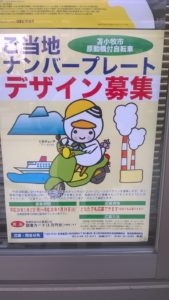
These may appear anecdotal, even frivolous, observations. However, they tally with research findings from other contexts (e.g. Parkhill et al, 2014), which suggest that citizens can have positive or at least nuanced relations to energy infrastructure in their surroundings. In the context of climate change, this means that the implications of transitioning carbon-intensive industries may go far beyond concerns over alternative employment or the sustainability of the regional economy to encompass issues such as loss of pride and sense of identity. Again, there is evidence from other empirical research (e.g. Milnes and Haney, 2017) indicating that relations between carbon-intensive industry and sense of self can trigger defensiveness towards reflection on local-level climate change actions.
In Tomakomai, by contrast, interviewees overwhelmingly viewed climate change as a challenge to rise to and opportunity for the city. This leads into the second insight – the key role that municipal and regional and governments have in framing climate responses in carbon-intensive regions in a way that is sensitive to the local context. In Tomakomai and also Iburi Subprefecture more widely, this is achieved by framing local pride and identity in industry as a force for good, weaving a narrative of the region as being a locale which is able to adapt to new innovations and to manufacture solutions. This is illustrated through Tomakomai City Government’s enthusiasm and support for hosting the CCS demonstration project (see Figure.5). Municipal-level actions for CCS deployment are led by the city’s Business Location Promotion Division, who are keen to capitalise on Tomakomai Bay’s geological suitability for carbon dioxide storage and readily-available sources of carbon dioxide and position the city as a front-runner within Japan for CCS innovation and low-carbon technology more widely (interview with Business Location Promotion Division, 2017).
Figure 5: the Tomakomai CCS Demonstration Project Capture and Injection Site
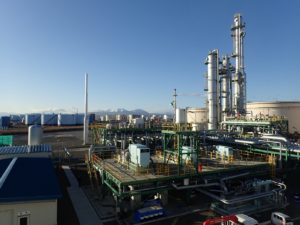
Indeed, whilst CCS as a technology is usually discussed as an activity of national importance due to the costs and technical complexity involved, in Tomakomai the Business Location Promotion Division – and the people within it – have been significant in moving the project to fruition. As well as working to situate the CCS project within a broader vision of Tomakomai as an innovative low-carbon city, the city government and its officials have had an important role in liaising with stakeholders to garner support for the CCS demonstration. Activities undertaken by Tomakomai City Government in this regard include acting as intermediaries between the project operator and the local fishing cooperative to obtain consent for injection under fishing grounds and to understand fishers’ marine monitoring requirements; getting buy-in from industrial stakeholders such as the Tomakomai City Chamber of Commerce by explaining the wider significance of the demonstration project for the city; and acting as a focal point to provide citizens with accessible data on the project. There is no indication of any serious or sustained opposition to the CCS Demonstration Project in Tomakomai. Yet the amount of work that has been done by the city’s Business Location Promotion Division to build support for the project within Tomakomai, much of it face-to-face and drawing on existing contacts, demonstrates that local government and local government officials, have an important job in getting buy-in for challenging and/or potentially contentious decisions which may have to be made as part of a managed transition.
At present, CCS is not itself a replacement for carbon-intensive industries in Tomakomai, given that it is a small-scale demonstration initiative. Nonetheless, what the CCS Demonstration Project does do is help to vision a transition to a lower-carbon future in the city, providing a tangible illustration of what a response to the climate challenge might look like for Tomakomai. As is now elaborated, this research has used the CCS project as a point of departure to stimulate discussion with stakeholders in Tomakomai and Japan more widely on what the social and cultural implications of a managed transition might be for a carbon-intensive region.
Building impact
Over and above the scholarly outputs from this research, this project haS also fed into governance and policy processes for CCS deployment in Japan, by emphasising the importance of understanding how new innovations and low-carbon transitions sit within the local socio-cultural context.
The initial outcomes of the RSA-supported research were presented as a keynote lecture at the Future of CCS Symposium held in Tokyo in December 2017. The symposium, attended by nearly 400 people from government, industry and academia, was hosted by the Ministry of Economy, Trade and Industry and aimed to situate carbon dioxide storage within a wider context of climate change mitigation actions in Japan. This gave an opportunity to narrate the history of industrial development in Tomakomai, and to provoke reflection on how relationships of trust built up over decades with developers and operators in Tomakomai could help to explain support for an otherwise potentially contentious development. In addition, a series of consultations and technical workshops held with the Engineering Advancement Association of Japan used the findings from Tomakomai to develop principles for assessing the social implications of future CCS development in Japan. Included within this were the importance of connecting CCS innovation and deployment with broader local narratives of low-carbon industrial transitions, and of collaboration with local government as a means of most appropriately framing CCS development and building local buy-in.
Figure 6: meeting with Akihiko Sasaki, Vice-Mayor of Tomakomai City.
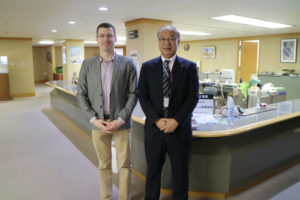
Figure 7: meeting with Prof Kazuhiro Kawashima, President of Tomakomai Komazawa University
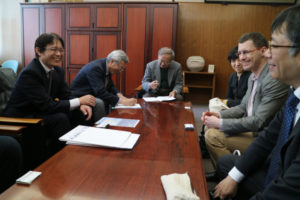
Research outcomes also fed back to stakeholders in Tomakomai City itself (see Figures 6 and 7). A public lecture was held in January 2018 at Tomakomai Komazawa University on the topic of ‘putting CCS in context’. In attendance were a range of local-level stakeholders, among them the Japan CCS Company, Tomakomai City Government, the Tomakomai City Chamber of Commerce, and the Principal of Tomakomai Komazawa University. This was followed up with a briefing with the Vice-Mayor of Tomakomai City and with the Business Location Promotion Division in Tomakomai City Government. In both cases, drawing on the findings from the research, the discussion focused on the possibility that the CCS Demonstration could be used as one of several initiatives in Tomakomai along with mega-solar, biomass and hydrogen developments, to build a narrative of using the manufacturing and innovation skills in the city to facilitate a low-carbon transition. There was also significant interest in learning from the experiences of Aberdeen, which as a result of its reliance on the oil and gas industries is facing similar challenges as energy systems are renewed and climate imperatives intensify. Indeed, collaboration and mutual learning between the cases of Aberdeen and Tomakomai was identified as an area of interest for future research, and ties in with increasing interest in learning between ‘ordinary’ or small cities as well as the just transitions movement.
It is worth noting that many of these opportunities for impact came about through the participation of key stakeholders in the research process itself. Particularly in a small city context such as Tomakomai, maintaining dialogue with participants across and beyond the fieldwork phase (e.g. providing updates on progress, sending through summaries and copies of research outputs) proved to be of significant value in opening up opportunities for dissemination later on in the research. Building opportunities into the interview schedule for discussion around knowledge gaps for managed transitions, and of the ways in which research outcomes could best be fed back to people in Tomakomai, was also helpful in enhancing the practical applicability of findings. From an early career researcher perspective, then, it is worth bearing in mind that some of the more ‘high-level’ impacts you might envision can be triggered through building good relations through small acts at the individual and interpersonal level.
Summary
Tomakomai City illustrates that carbon-intensive industries such as petrochemicals and paper manufacturing can come to be integral to citizens’ sense of place. As such, the presence of favourable economic conditions and available resources, whilst certainly helpful, may be just one factor influencing the likelihood of a managed low-carbon transition taking root in a city or region which has deep connections to industries associated with high emissions. Finding ways to rigorously and systematically assess the socio-cultural landscape is hence an important part of understanding how low-carbon innovations can best be framed to get broad-based buy-in in carbon-intensive contexts such as Tomakomai.
Acknowledgements
Special thanks are extended to the Engineering Advancement Association of Japan; the Japan CCS Company; Jun Kita of the Marine Ecology Research Institute; and Prof Kazuhiro Kawashima of Tomakomai Komazawa University for support with the fieldwork and exchange on which this article is based. The research was possible thanks to a Regional Studies Association Early Career Grant received by Leslie Mabon.
References
Government of Japan (2015) ‘Submission of Japan’s Intended Nationally Determined Contribution (INDC)’ Government of Japan: Tokyo.Hokkaido Electric (2018) ‘Thermal power stations at a glance’(in Japanese)
Hokkaido Governnemt (2018) ‘Situation of damage etc from the 2018 Hokkaido Eastern Iburi Earthquake: No. 14’ (in Japanese) http://www.pref.hokkaido.lg.jp/sm/ktk/300906/higaihou14.pdf
Japan CCS Company (2018) ‘Tomakomai CCS Demonstration Project’
Mabon L, Kita J and Xue Z (2017) ‘Challenges for social impact assessment in coastal regions: a case study of the Tomakomai CCS project’ Marine Policy 83: 243-251
Mabon L and Shih W-Y (2018) ‘Management of sustainability transitions through planning in shrinking resource city contexts: an evaluation of Yubari City, Japan’ Journal of Environmental Policy and Planning DOI: 10.1080/1523908X.2018.1443004
Milnes T and Haney TJ (2017) ‘‘There’s always winners and losers’: traditional masculinity, resource dependence and post-disaster environmental complacency’ Environmental Sociology DOI: doi.org/10.1080/23251042.2017.1295837
Parkhill K, Butler C and Pidgeon N (2014) ‘Landscapes of Threat? Exploring Discourses of Stigma around Large Energy Developments’ Landscape Research 39(5): 566-582.
Tomakomai City (2017) Tomakomai City Statistics Handbook (in Japanese) Tomakomai City Government: Tomakomai.